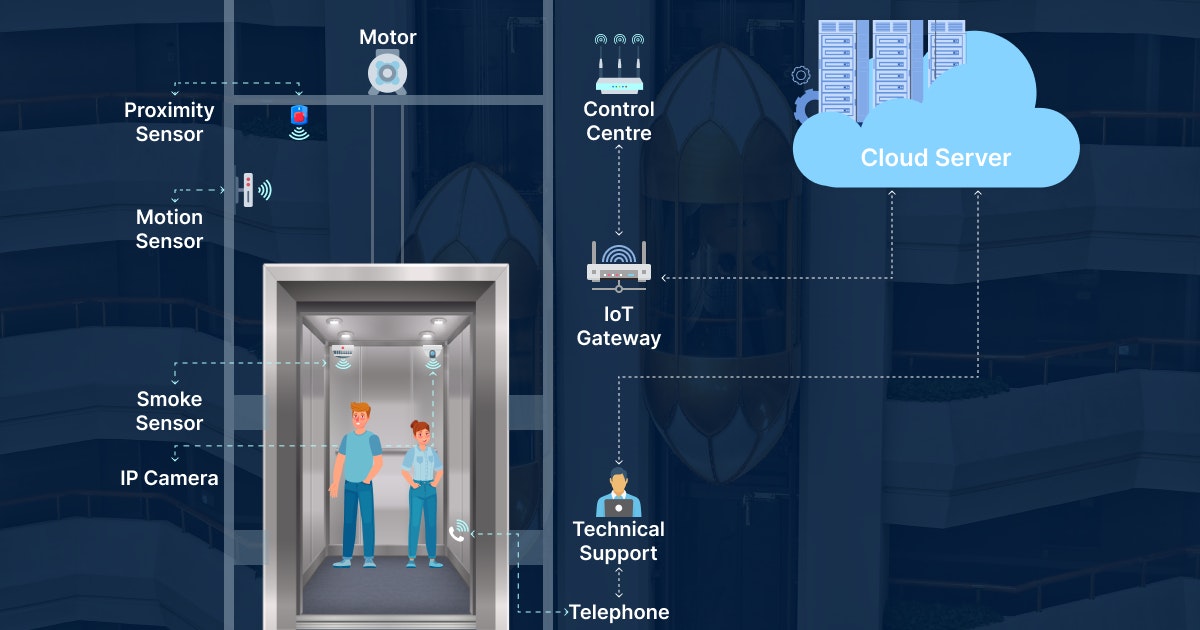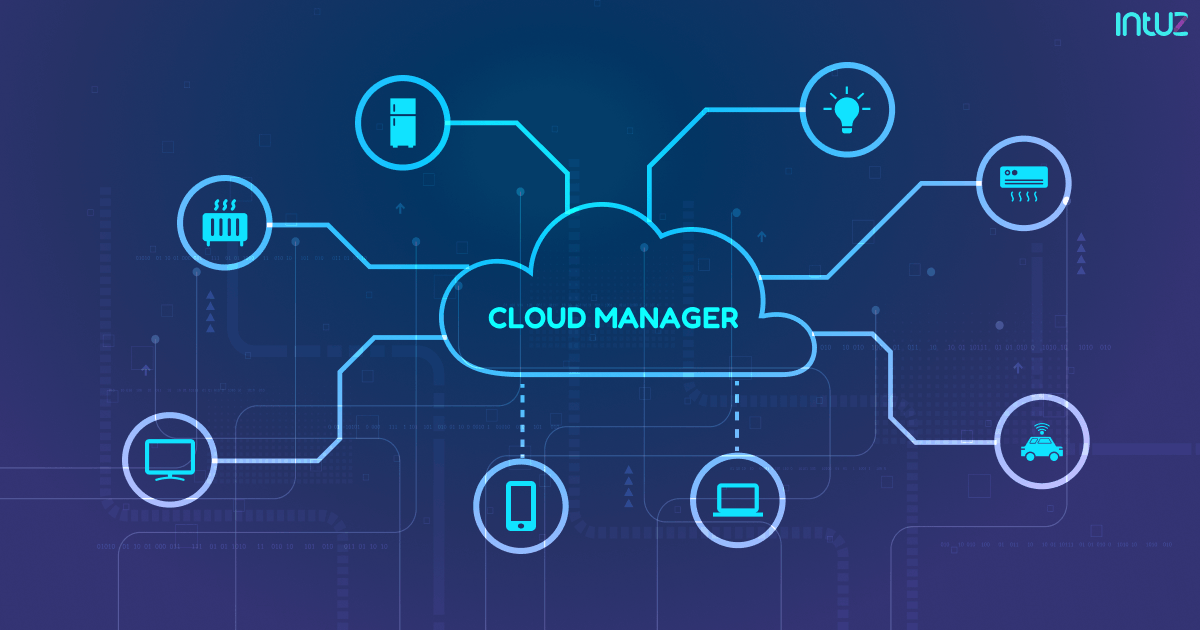Table of Content
Look around yourself - no urban space is complete without an elevator. General people use elevators to move between floors in offices and shopping centers. They use it in their daily commute to work. Undoubtedly, the use of elevators and commodity transportation has grown over time with the surge in urbanization.
Carbon fiber ropes and more durable machinery keep them moving. Let us also not forget the exteriors of a typical elevator that has undergone a makeover with time. IoT has taken the elevator business a step further.
IoT technology has enabled elevators to become smarter by improving their functionalities and safety protocols. Technology is changing elevators beyond getting people up and down buildings quickly and easily.
Today, smart elevators collect data, monitor traffic flows, and act as powerful advertising tools. The remote monitoring of elevators and their preventive maintenance help reduce service interruptions and minimize downtime.
The user experience can also be optimized by using IoT to lower waiting periods and offer mobile connectivity. That is the magic of IoT!
What is an IoT-enabled smart elevator system?
An IoT-enabled smart elevator uses custom hardware to connect with a controller through a Wi-Fi or LAN interface. It communicates through signals generated by changes in the GPIO (general-purpose input/output) pin or UART (universal asynchronous receiver-transmitter).
The hardware detects any changes in the signal, and the communication is shared with the IoT central hub. The transmitted data is processed by the logic application layer of the hub to detect and predict a fault. It uses the WebSocket to communicate with a user interface and transmit a meaningful signal.
Key market insights for elevator construction
The construction market worldwide is estimated to reach $24,334.9 billion in the coming years, and the demand for smarter elevators is on the rise, boosting the IoT-driven elevator market.
Some countries in North America and Europe even have regulations to maintain records of the usage, inspections, and maintenance of elevators. Smart elevator solutions are helpful for safer use and regulatory compliance related to residential and commercial amenities.
The recent advancements in the elevator industry use IoT and AI, enabling it to become more efficient, safe, and reliable.
These innovations have been introduced to improve passenger experience as well as increase revenue generation for companies by eliminating downtime from maintenance work.
Best smart elevator technologies
Sensors
- Accelerometers and gyroscopes to monitor elevator movement
- Load sensors to detect weight and occupancy
- Proximity sensors for door control
- Vibration sensors to detect mechanical issues
Connectivity
- Bluetooth Low Energy (BLE) for short-range communication with user devices
- Wi-Fi, cellular (4G/5G), or wired ethernet for data transmission
Artificial Intelligence (AI) and Machine Learning (ML)
- For predictive maintenance to anticipate potential failures
- Traffic analysis to optimize elevator dispatch and reduce wait times
Cloud computing
- For data storage, analysis, and remote monitoring
- Enables predictive maintenance and performance optimization
Mobile applications
- Allow users to call elevators and select destinations via smartphones
- Provide accessibility features for users with disabilities
Enhance Elevator Performance and Safety with IoT!
Let's Get StartedKey players in the global IoT-powered elevators market
Unless you have been living under a rock, you will be aware that IoT-enabled elevators use AI to conveniently enable the vertical transportation of passengers and commodities. You need to keep upgrading an elevator's critical parts and ensure that it keeps functioning safely.
Thankfully, many companies do their job well and deliver exceptional elevators for commercial and residential use. Adding to that thought, here are the key global players when it comes to developing IoT smart elevators:
- Fujitec Co
- Hitachi Ltd
- Toshiba Elevators
- Schindler Group
- ThyssenKrupp AG
- Kone Corporation
- Otis Elevator Company
- Hyundai Elevator Co. Ltd
- Mitsubishi Electric Corporation
Why deploying a smart elevator solution is a good idea?
Adopting the new generation of IoT elevators is more beneficial than using the traditional ones as they are highly efficient. They eliminate the need for manual maintenance, testing, and tracking records of every machine individually.
Installing a smart elevator system is cost-effective, and managing it is less time-consuming. Here is why deploying a smart elevator solution is a good idea:
1. Avoid unauthorized access
Smart elevators can allow access to authorized personnel only through fingerprints or a smart card - connected to an RS232 DB9 connector and using a UART for data sharing.
It uses PSOC6 hardware to read the register when the fingerprint or smart card is punched. The signal is transferred to the IoT-enabled public cloud using the Modbus protocol.
The information is verified in real-time, and the person gets access to the elevator only if authorized to use it. Smart cards are used in many 5-star hotel chains to grant access to specific floors to customers as per their membership status with the hotel.
2. Predict destination
The smart elevator system uses AI for face recognition and retrieves user information from the IoT-enabled cloud in real time. The ML algorithm reviews historical data to define the destination floor of the user.
If the user data indicates visits to multiple floors, then the VoIP protocol is activated to communicate with the user. A voice message from the elevator enquires about the destination and records the user's response.
Users can define the destination floor using a voice command. It is a smart solution to avoid contacting surfaces in a sensitive environment or during a pandemic.
Features of smart elevators
Smart elevators can make real-time maintenance decisions, monitor performance, offer advanced reporting, and provide updated status. A smart elevator has the following features:
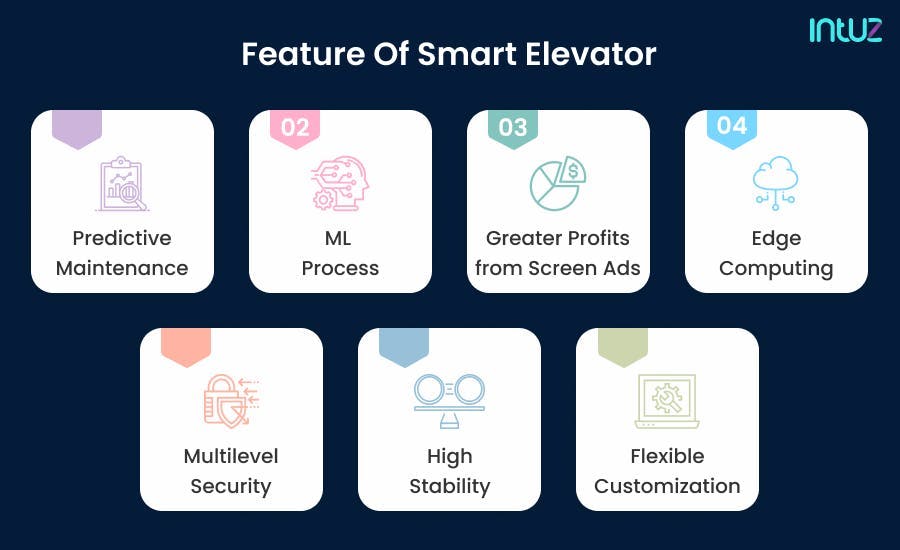
Features of smart elevators
1. Predictive maintenance
The use of IoT in the elevator and escalator industry is being recognized for its potential to reduce costly downtime. Smart elevators can tap into the power of predictive maintenance and detect problems before they arise.
This leads to greater efficiency and lesser expenses due to limited repair work. The system automates maintenance monitoring to minimize human intervention and reduce downtime. Which facility manager does not want that?
2. ML process
Machine learning enables elevator technicians to anticipate problems and manage traffic throughout the equipment's life cycle. They can make repair and replacement decisions based on data collected by the system.
A technician can, for example, use analytics to recommend the best course based on daily usage. Besides resolving ongoing issues, they can detect potential problems and take corrective measures to fix them before they arise.
3. Greater profits from screen ads
An elevator is a great place to advertise your business, especially if you are targeting tenants or customers. Advertisers can reach a broader audience and grab their attention with targeted advertising inside an elevator.
The viewing opportunity in an elevator taxi is much higher than when the audience simply passes by a poster or screen in a public space. IoT solutions empower you to monetize mobility spaces with a simplified backend for easier management.
4. Edge computing
To ensure the safety and security of passengers in an emergency, you need to initiate a faster response time from an elevator.
In smart elevators, the edge computing nodes of the network collect video and images of the interiors to quickly share the information with the facility manager and the elevator's geographic position to prevent any mishaps or security lapses.
5. Multi-level security
Smart elevator security systems provide complete security. A smart card reader can control floor access. It helps prevent unauthorized people from entering the building. A CCTV camera surveillance system allows 24 hours monitoring of the elevator to maintain security.
6. High stability
Smart elevator solutions use IoT devices and gateways to connect wirelessly and facilitate remote management. The IoT sensors and nodes fetch and store data analyzed on the IoT platform. It helps identify maintenance needs and ensure the elevator's stability.
7. Flexible customization
Elevators can be customized in many different ways. You can choose the lights and wall panels of your elevator's interiors and pick varying materials for the exterior. You can personalize the ambiance using sensors and hardware controlled by a mobile app.
This level of customization helps create a space that suits different moods and meets changing needs of the customer base.
Types of smart sensors used in smart elevators
Sensors are generally used in the architecture of IoT devices. As the name suggests, they sense things and devices, providing a usable output in response to a specific measurement. Smart elevators also make use of smart sensors, including:
1. Current Sensor
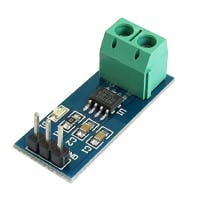
Current sensor
A current sensor is a device to detect the current and convert it into an output voltage. It is easily measurable and proportional to the current through the measured path. Many sensors work for specific current ranges and environmental conditions.
2. Motor Sensor
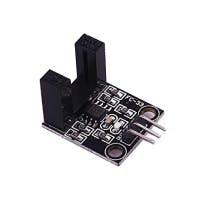
Motor sensor
Also known as a thermocouple, a motor sensor is used for motor temperature monitoring. It is a sensor in smart sensors to control overheating. The motor current monitoring sensor (or the amp clamp) is mounted on the motor or the gearbox and measures the motor's electrical current. It detects an overload when the current flow to the sensor is high.
3. Encoder
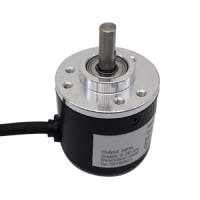
Encoder
An encoder is a combinational circuit that encodes 2^n inputs into an n-bit code. It produces a binary code equivalent to the input. The encoder has a maximum of 2^n input and 'n' output lines. An encoder's operations are the reverse of the decoder.
4. Smoke Sensor
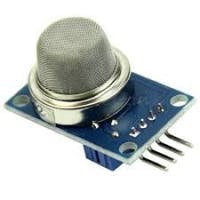
Smoke sensor
A smoke sensor detects fire through the presence of smoke and temperature changes in an environment. It triggers an alarm and indicates through light in case of a fire. The device also sends notifications over your mobile phone to keep you informed even when you are away.
5. Photoelectric Sensor
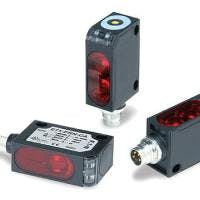
Photoelectric sensor
The photoelectric sensor is a device that can determine the presence of an object by measuring how much light reaches its receiver. These sensors often find use in industrial manufacturing facilities. The sensors also help in estimating the distance. The three types of sensors are opposed (through-beam), retro-reflective, and proximity-sensing (diffused).
6. Motion Sensor
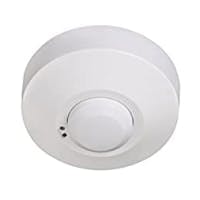
Motion sensor
A motion sensor detects and measures movement using a sensor unit. The embedded computer processes the signals to activate connected systems and trigger alarms. Depending upon their components and usage, the sensors may be classified as active motion sensors and passive motion sensors.
7. Earthquake Countermeasure
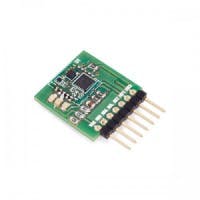
Earthquake countermeasure
Seismic sensors are velocity sensors or accelerometers that detect earthquake vibrations or tremors. They may trigger an alarm or even automatically shut off fuel or electricity supplies in the elevator. Such sensors may be classified as P-wave sensors that detect the initial tremors and S-wave sensors that detect the major earthquakes.
8. Proximity Sensors
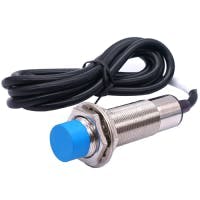
Proximity sensors
Proximity sensors emit electromagnetic radiation to detect the presence of objects without any physical contact. Differentiation of sensors is based on the material to be sensed. Capacitive proximity sensors or photoelectric sensors are suitable for plastic targets. On the other hand, an inductive proximity sensor helps detect metal targets.
How do IoT smart lift systems work?
The IoT elevator market presents many opportunities for companies looking to save time and money. The devices include the M2M gateway and elevator gateway. Other offerings are software to run the IoT devices and on-premise or cloud services for data storage.
Services in the IoT elevator market include designing custom elevators, engineering, and deploying elevator components. In this day and age, you should not ignore regular maintenance and repair work. Traditional machines can be refurbished to build smart elevators.
IoT devices are a powerful tool for orchestrating maintenance operations. Their ability to analyze large streams of performance data and predict future requirements eliminates the need for manual processes.
Such IoT-powered devices can monitor operating conditions to detect any maintenance requirements. They keep track of critical safety circuits, the number of door cycles and trips, load weighing, wait times, and traffic trends.
IoT devices are built using models that keep track of heat, friction, and noise to detect wear and tear. Analyzing the data collected, the systems predict maintenance needs. The arrangement easily helps bring down costs and minimize downtime.
IoT elevator monitoring devices provide a constant stream of real-time data, enabling service professionals to monitor the health of the equipment remotely and diagnose problems early on. They are ready with solutions when they reach the elevator.
IoT-powered elevators save precious on-site time as technicians do not waste any effort or company money on unknown concerns. The maintenance activities can also be planned in time slots other than peak hours.
IoT In Blockchain: Benefits, Use Cases, and Challenges
Learn MoreBenefits of smart elevator monitoring solutions
Besides offering a comfortable commuting experience with minimum waiting time, user safety, and traffic management, you can enjoy many more benefits of smart elevators, and that includes:
1. Maintenance prediction
Any anomaly in the elevator's I/O pin or register value is reported as a fault. The ML model uses the GPIO pin and generated fault to predict the level of maintenance required. Elevator status changes can be traced through GPIO pin changes.
2. Live elevator monitoring
A smart elevator shares dynamic information like the current position, direction, state, and door status of an elevator. The information is sent to the IoT central hub, and a live update is shared on the user interface. This feature allows remote monitoring of the elevator, location, status, and fault.
3. Remote controlling
The IoT central system eliminates the need for physical human intervention. Smart elevators use voice commands and can be controlled remotely through mobile apps for functions such as start-stop or switch on/off actions. The technology reduces the need for physical switches and unnecessary human resources for maintenance.
4. Remote testing
Faults in smart elevators will be identified using the GPIO pin, and technicians can look at the GPIO value to debug the elevator issues remotely. The elevator's active high value and GPIO pin testing value allow the technician to remotely identify the causes of elevator failure.
5. Cost-effectiveness
The cost of hiring an elevator technician is very high. IoT allows central control of an elevator. It can be remotely operated and tested, reducing the technician's cost. Power consumption can also be reduced by setting the rules for usage and time threshold.
6. Zero downtime
Elevator downtime can be reduced by utilizing IoT. You can track power failures and specify rules for when an elevator should be started on backup. Track further timeout of the backup power and elevator downtime can be reduced by setting up rules for usage during a power cut.
Are You an Elevator Manufacturer Ready to Transform with IoT-Enabled Smart Elevators?
Contact UsThe future of the IoT elevators market
The IoT elevator market has the potential to grow manifold in the coming years owing to the rising demand for smart equipment in construction. The recent advancements in IoT and AI technologies are making elevators smarter, leaving room for greater automation.
The time and cost of maintenance and repair also reduce with the decrease in human intervention. In addition to remote monitoring and controlling by the 2030s, the elevators are predicted to have 'minds of their own.'
In a new smart building ecosystem, elevators can communicate with servers to deliver a better user experience - with minimum hassle and no downtime.
You can also expect the next generation of IoT elevators to include machines that can hold doors longer for elderly passengers, offer a tailored journey based on facial recognition, and help determine the optimal time to leave and return home.
Book a Free 45-minute Consultation with Our IoT Experts Today! Get a customized roadmap and strategies to leverage IoT to create smart and safe elevators.
